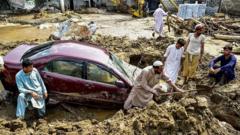More than 200 individuals remain missing in the Buner district of northwestern Pakistan following catastrophic flooding and landslides that have left a wake of devastation in recent days. As of now, authorities have recorded over 300 fatalities across Pakistan and Pakistan-administered Kashmir due to the relentless monsoon rains.
Local officials confirmed that at least 209 people are unaccounted for in Buner, and there are concerns that this figure may rise. Jehangir Khan, a spokesperson for the deputy commissioner’s office in Buner, reported that rescue teams have buried eight unidentified bodies due to a lack of family members to claim them, further complicating the situation as many roads remain obstructed.
In addition, a provincial rescue spokesperson highlighted that "10 to 12 entire villages" were partially buried. Meanwhile, in the neighboring Shangla district, the head of the provincial disaster management authority mentioned that "dozens" of other individuals are also missing.
The monsoon season in South Asia typically runs from June to September, bringing with it about three-quarters of the region's annual rainfall. However, scientists warn that climate change is making such extreme weather events more frequent and severe.
In the midst of this disaster, devastating rains have also affected Indian-administered Kashmir, where flash floods in recent days have claimed at least 60 lives. The situation is similarly dire in Pakistan-administered Kashmir, where nine fatalities have been reported, alongside five additional deaths in the northern Gilgit-Baltistan region.
Government forecasts indicate that heavy rainfall will persist until August 21 in the worst-affected northwestern regions, designated as disaster zones following widespread destruction. In fact, this year's monsoon season has already resulted in over 650 deaths across Pakistan, with the province of Punjab experiencing a staggering 73% increase in rainfall compared to last year.
While the precise causes of the catastrophic floods and landslides are still being investigated, glaciologists suggest that the rapid melting of glaciers in the region, driven by climate change, is exacerbating the risk of debris and landslides. This melting not only destabilizes the land but also threatens to block river courses, leading to even greater flooding risks.


















